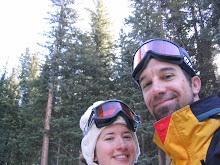from Glenn: i've been thinking lately what i'll encounter in culture shock when we return to the states - thus far, it will be: that there is life after noon on Saturdays and Sundays - all the stores close early and the streets are nearly desolate; people don't end their comments or agree with you w/ the sound "aaaay" - that's about it -
from Amy: i don't think about such things, i like to think about what i'm going to be eating this week. the nice thing about living here is that everyday i leave work at 4:30, even if there is more work to do, everyone goes home, there's no such thing as overtime. as a result, i get to eat dinner for real every night. it's quite thrilling to think that i'm in control of how many vegetables i get to eat, or not eat. but we kind of blew our budget for the month of july, so this week we'll be eating lasagna every single night (which is my favorite food) with no wine.
We visited the largest and oldest meteorite impact on the planet earth. Last week we drove 30 minutes out of town to the Vrederfort Dome where we saw mountains, monkeys, and hiraxes! (yes hyraxes, if i wasn't paying per megabyte i'd upload you a picture, you'll have to figure it out yourself). We went up and down and around a mountain on foot. It was 2 and a half hours of pure bliss. The peace corps has been trying to turn us into city kids, keeping us in this concrete jungle for so many months, we finally got to break free. We went with a fellow south african another pc volunteer (a geologist!) who shared a wealth of knowledge of our surroundings. Then we went to this little town nearby where they have a spice store where they sell bay leaves! basmati rice! and other wonders.
Sunday, July 26, 2009
Subscribe to:
Post Comments (Atom)

1 comment:
The hyrax, also called rock rabbit or dassie, is a small furry mammal. It looks like a robust, oversized guinea pig, or a rabbit with rounded ears and no tail. Hyraxes have stumpy toes with hooflike nails, four toes on each front foot and three on each back foot. The longer, clawlike nails on the inside toes of the back feet are used for grooming and scratching. The bottoms of the feet have a rubbery texture to assist in climbing steep rock surfaces and trees.
Of the three hyrax species, two are known as rock (or bush) hyrax and the third as tree hyrax. In the field it is sometimes difficult to differentiate among them.
The rock hyrax has the widest distribution in East Africa. Its coat is yellowish or grayish-brown, and the dorsal spot (a bare scent gland on the back covered with longer hair) is covered with black or yellow hair. Its head is more rounded than other types of hyraxes, and the nose is blunt.
I had never heard of this animal until now, so I thought I'd look one up and share with others who, like me, have never seen a hyrax in the flesh LOL. Love you Both, MUM
Post a Comment